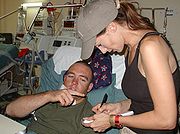
Armed Forces Entertainment
Encyclopedia




United States Department of Defense
The United States Department of Defense is the U.S...
(DoD) agency for providing entertainment to U.S. military
Military of the United States
The United States Armed Forces are the military forces of the United States. They consist of the Army, Navy, Marine Corps, Air Force, and Coast Guard.The United States has a strong tradition of civilian control of the military...
personnel overseas. Armed Forces Entertainment hosts over 1,200 shows around the world each year, reaching over 500,000 personnel at 355 military installations. Types of talent include musicians, comedians, cheerleaders, and celebrities of sports, movies and television.
Armed Forces Entertainment was founded in 1951 to provide up-and-coming American entertainment to US troops and their family members stationed overseas, with priority to remote and isolated locations, ships at sea, and contingency operations. Entertainment is provided to the Army
United States Army
The United States Army is the main branch of the United States Armed Forces responsible for land-based military operations. It is the largest and oldest established branch of the U.S. military, and is one of seven U.S. uniformed services...
, Navy
United States Navy
The United States Navy is the naval warfare service branch of the United States Armed Forces and one of the seven uniformed services of the United States. The U.S. Navy is the largest in the world; its battle fleet tonnage is greater than that of the next 13 largest navies combined. The U.S...
, Air Force
United States Air Force
The United States Air Force is the aerial warfare service branch of the United States Armed Forces and one of the American uniformed services. Initially part of the United States Army, the USAF was formed as a separate branch of the military on September 18, 1947 under the National Security Act of...
, Marine Corps
United States Marine Corps
The United States Marine Corps is a branch of the United States Armed Forces responsible for providing power projection from the sea, using the mobility of the United States Navy to deliver combined-arms task forces rapidly. It is one of seven uniformed services of the United States...
and Coast Guard
United States Coast Guard
The United States Coast Guard is a branch of the United States Armed Forces and one of the seven U.S. uniformed services. The Coast Guard is a maritime, military, multi-mission service unique among the military branches for having a maritime law enforcement mission and a federal regulatory agency...
. This is different from the non-government United Service Organizations
United Service Organizations
The United Service Organizations Inc. is a private, nonprofit organization that provides morale and recreational services to members of the U.S. military, with programs in 160 centers worldwide. Since 1941, it has worked in partnership with the Department of Defense , and has provided support and...
(USO), whose entertainers tend to be famous, and generally aren't sent as close to the front line.
Armed Forces Entertainment is an Air Force
United States Air Force
The United States Air Force is the aerial warfare service branch of the United States Armed Forces and one of the American uniformed services. Initially part of the United States Army, the USAF was formed as a separate branch of the military on September 18, 1947 under the National Security Act of...
command operation and is the single point of contact with the DoD for providing entertainment to US military personnel serving overseas. It is the lead agency in providing transportation and logistical support for the USO in bringing celebrity entertainers to troops.
Armed Forces Entertainment typically showcases emerging artists but also features celebrity acts such as Kid Rock
Kid Rock
Robert James "Bob" Ritchie , known by his stage name Kid Rock, is an American singer-songwriter, musician and rapper with five Grammy Awards nominations...
and Drew Carey
Drew Carey
Drew Allison Carey is an American actor, singer, comedian, photographer, sports executive, and game show host. After serving in the U.S. Marine Corps and making a name for himself in stand-up comedy, Carey eventually gained popularity starring on his own sitcom, The Drew Carey Show, and serving as...
.
The responsible organization for overseas military entertainment has changed names and jurisdictions over its first five decades; from the United Services Organization Camp Shows to the U.S. Army’s Armed Forces Professional Entertainment Office (AFPEO) and resting in 2006 with the U.S. Air Force’s Armed Forces Entertainment office. However, the mission has remained constant: to provide a program of live, professional entertainment to enhance the quality of life for Armed Forces personnel.
History
- World War II-1951: The United Service Organizations (USO) Camp Shows program recruited and fielded live entertainment for military personnel. Camp Shows usually consisted of well-known celebrities who were recruited to entertain military personnel serving overseas. For many entertainers, this was their first time performing and traveling abroad. However, the Camp Shows scheduling, which was coordinated by each Service, was considered inconsistent.
- 1951-1970: Before the establishment of the Department of Defense (DoD) in 1951, the Military Services agreed to provide a single point of contact for the USO. The Secretary of the Army was designated as the administrative agent for the DoD's relationship with the USO. Operational responsibility rested with the Adjutant General, then transferred to the Commander, U.S. Army Community and Family Support Center. In 1951, Service representatives were assigned to the new Armed Forces Professional Entertainment Office (AFPEO) to administer the fielding of USO Shows, provide shows where the USO Camp Shows were unavailable, and establish a regularly scheduled program.
- Units consisted of celebrities, professional artists, college groups sponsored by the American Theater Association (ATA) and the All American Collegiate Talent Showcase (ACTS). The USO and DoD sent thousands of entertainers, celebrity and non-celebrity, to entertain U.S. military personnel, DoD and Department of State civilians, and their family members worldwide. By the end of the Vietnam era, virtually all of the programmed shows were non-celebrity with DoD fielding over half of the units.
- 1982: The USOUnited Service OrganizationsThe United Service Organizations Inc. is a private, nonprofit organization that provides morale and recreational services to members of the U.S. military, with programs in 160 centers worldwide. Since 1941, it has worked in partnership with the Department of Defense , and has provided support and...
cancelled the non-celebrity program to concentrate on the recruitment and fielding of well-known celebrity entertainment. The DoD directed the Secretary of the Army to assume responsibility for the non-celebrity program. In June, all non-celebrity entertainment units sent abroad were participating in the Armed Forces Professional Entertainment Program overseas, nicknamed "DoD Overseas Shows". In addition to the non-celebrity program, the AFPEO continued to uphold DoD's portion of the celebrity show responsibilities with the USO. These shows were renamed "USO/DoD Celebrity Shows." - 1989: The Assistant Secretary of Defense (Personnel and Readiness) assumed operational control of the AFPEO with the Secretary of the Army remaining the Executive Agent. This assumption was designed to elevate the AFPEO's authority, facilitate coordination, and increase program visibility.
- 1997: The U.S. Air Force was assigned the Executive Agent for providing celebrity and non-celebrity programs to troops serving overseas, creating the jointly-manned office, Armed Forces Entertainment.
- 2008: First year of the Coaches TourCoaches TourCoaches Tour is a program where college football coaches would visit the U.S. troops in the Middle East to provide entertainment relief. CoachesTour 2008 was the first year of the program, sponsored by Morale Entertainment, LLC...
where college football coaches would visit the U.S. troops in the Middle East to provide entertainment relief.
External links
- Official site of Armed Forces Entertainment - As this is a work of the U.S. government, text from it is (unless stated otherwise) in the public domain, and some of it has been incorporated into this article.

